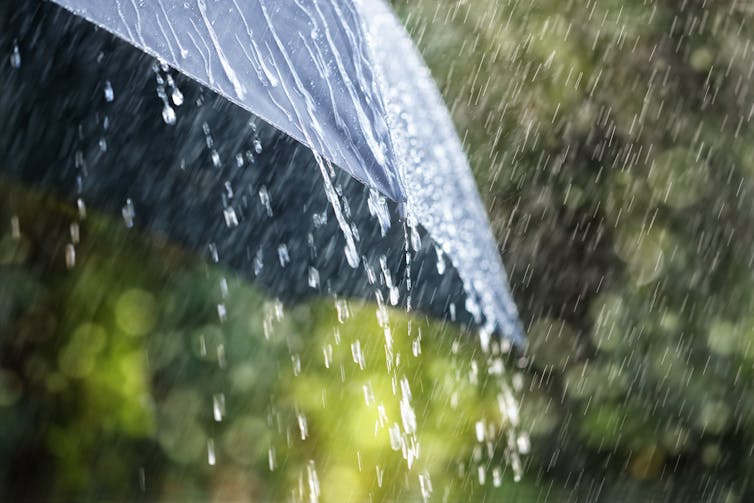Why hay fever is so bad in the UK right now – and why thunderstorms make things worse for people with allergies and asthma

The UK is in the grip of a particularly bad period for hay fever, with people across the nation experiencing a relentless onslaught of sneezing, itchy eyes and nasal congestion.
Visits to the NHS hay fever advice page have increased by 252% since the beginning of May, signifying the magnitude of the problem.
This common seasonal affliction is a hypersensitive reaction to allergens, most notably pollen. Typically associated with spring and early summer, hay fever symptoms appear to have intensified in the UK in recent weeks.
The question on many people’s minds is: why is it so bad right now? A number of environmental factors may be contributing to the current hay fever havoc – including thunderstorms, which can exacerbate symptoms for people with allergies as well as asthma.
Changes in weather patterns, such as increasing temperatures and more intense rainfall, and extended flowering seasons as a result of these trends, can have a significant influence on pollen production.
In particular, higher temperatures and elevated atmospheric carbon dioxide levels, which are primarily occurring as a result of climate change, have been shown to stimulate plant growth and enhance pollen production.
It’s likely these factors are contributing to longer pollen seasons and higher concentrations of allergenic pollen in the air, explaining why people are reporting hay fever symptoms at such high levels.
What about thunderstorms?
Hot weather often paves the way for thunderstorms, and some parts of the UK have had severe storms in recent days.
The interaction between thunderstorms and respiratory conditions can lead to heightened symptoms – not only for people with hay fever, but for those with asthma as well.
The phenomenon of thunderstorm asthma has been observed in various parts of the world, and is characterised by a sudden surge in asthma attacks and respiratory distress following a thunderstorm.
We don’t yet fully understand the precise mechanisms underlying thunderstorm asthma, but it’s likely the contributing factors are similar to those which explain why thunderstorms can worsen allergy symptoms.
During thunderstorms, a process called pollen fragmentation occurs, where rainwater breaks down pollen granules into smaller particles. These fragmented pollen particles are then dispersed into the air, which can increase pollen concentrations.
Notably, due to their smaller size, these particles can penetrate deeper into our airways. As a result, people with hay fever and asthma may face more severe symptoms after a thunderstorm when we’re exposed to these fragmented pollen particles, compared to intact pollen grains alone.
The process of pollen fragmentation during thunderstorms can also release allergenic proteins, making the pollen particles more potent. This can trigger more severe allergic responses in both asthma and hay fever sufferers.
Meanwhile, thunderstorms can also release irritant particles and pollutants, such as dust and ozone, which can irritate the airways and exacerbate respiratory symptoms in people with asthma and hay fever.

These factors highlight the complex interplay between environmental triggers, pollen characteristics and respiratory health in relation to hay fever and asthma. Understanding these mechanisms can hopefully help us in developing effective strategies for managing and mitigating the effects of these conditions.
How can I manage my hay fever symptoms?
Pollen levels look set to remain high across much of the UK in the coming days, and possibly for some time after that if the current weather conditions continue. If you’re struggling with hay fever symptoms, here are a few tips.
Check the pollen count in your area: This information can be found through the Met Office, local weather forecasts, online pollen trackers, or smartphone apps. Adjust your activities and precautions accordingly. For example, on days when the pollen count is high, it’s a good idea to stay indoors where possible, with windows and doors closed, to minimise pollen exposure.
Practice good hygiene: After spending time outdoors, take a shower and change your clothes to remove any pollen that may have accumulated on your body or clothing. This reduces the likelihood of bringing pollen into your living spaces.
Use filters: If you drive, consider investing in a pollen filter for your car’s ventilation system to reduce the amount of pollen that enters the vehicle while travelling. Additionally, using a high-efficiency particulate air (Hepa) filter at home can help remove pollen and other allergens from indoor air.
Avoid triggers: Refrain from mowing the lawn or spending prolonged periods in freshly cut grass, as this can stir up pollen particles. Similarly, keeping fresh flowers inside the house can introduce additional allergens into the environment, so it’s best to avoid having these indoors during hay fever season.
Create a barrier: Try applying petroleum jelly around the nostrils. This creates a barrier that can trap pollen and reduce its entry into the nasal passages, thereby providing some relief.
While these tips can help alleviate symptoms, it’s important to consult with a healthcare professional for personalised advice and treatment options. They can provide guidance on suitable medications, immunotherapy, or other interventions to help manage your hay fever or asthma effectively.![]()
By Samuel J. White, Senior Lecturer in Genetic Immunology, Nottingham Trent University and Philippe B. Wilson, Professor of One Health, Nottingham Trent University
This article is republished from The Conversation
Spotted something? Got a story? Send a Facebook Message | A direct message on Twitter | Email: [email protected]Latest News








